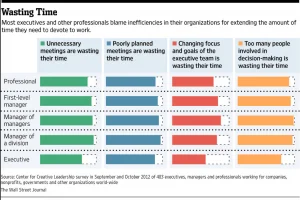They’re worse than sitting in traffic. They’re sturdier than cockroaches. And that’s why — despite the near universal agreement on their uselessness — the weekly team meeting refuses to go away.
Jeff Denneen, a Bain and Company partner, wants to help. As he wrote in LinkedIn, he and his team studied the problem and discovered the “ripple effect those unproductive meetings have on an organization, especially when top executives meet. My Bain colleague Michael Mankins and his team analyzed time use at one large company and found that people there spent 300,000 hours a year just supporting the weekly executive committee meeting. Using data-mining tools to analyze the Outlook schedules of everyone in the company, they found that the executive committee meeting required preparation and ancillary meetings by unit heads, senior advisers, teams … and more teams. You get the point. The meeting prep radiates outward like a forest fire consuming widening circles of employees.”
Some of the solutions seem straightforward, but they go to the heart of why the meetings live on:
- “Have a purpose. If you don’t know why you’re meeting, don’t meet!”
- “Manage the invite list. Remember the Rule of 7, which states that every attendee over a total of 7 reduces the likelihood of making a good, quick, executable decision by 10 percent.”
- “Change the default time. Not too long ago, most companies called 30-minute meetings. Now the typical default time has grown to 60 minutes, even though every additional minute generates a higher cost.”
 Indeed, a Center for Creative Leadership survey published in the Wall St. Journal shows, many executives feel that they have to spend more time working because of their organizations’ inefficiencies.
Indeed, a Center for Creative Leadership survey published in the Wall St. Journal shows, many executives feel that they have to spend more time working because of their organizations’ inefficiencies.
Instead of a weekly meeting, Oregon Business writes that companies may want to consider focusing on “a team’s energy and engagement outside formal meetings.”
The piece continues: “Joaquin Lippincott, the president of Metal Toad Media, a Portland-based company that provides web consulting and implementation, understands this concept. ‘Every Monday and Thursday, we have a company-wide stand-up meeting where we touch on an agenda. But it’s mostly to give high-fives,’ he says. High fives? ‘It’s where we engage in individual connections, mention people who’ve helped out on a project, get the whole company excited and aware about things.’”
High fives instead of pointless weekly status updates? It just might work.
